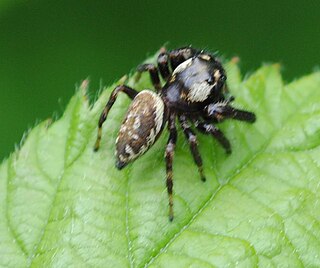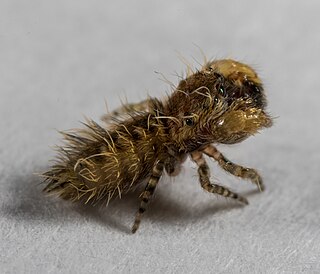
Attulus is a genus of jumping spiders that was first described by Eugène Louis Simon in 1889. The name is a diminutive form of a common prefix for salticid genera, -attus.

Heliophanus is a genus of the spider family Salticidae. Most of the almost 170 described species occur in Africa, with many others found in the Palearctic region from Europe to Japan.

Macaroeris is a spider genus of the jumping spider family, Salticidae.

Pellenes is a genus of jumping spiders that was first described by Eugène Louis Simon in 1876. It is considered a senior synonym of Hyllothyene.
Plexippoides is a genus of jumping spiders that was first described by Jerzy Prószyński in 1984. The name means "having the likeness of Plexippus"
Proszynskiana is a genus of Asian jumping spiders that was first described by D. V. Logunov in 1996. It is named in honor of arachnologist Jerzy Prószyński.

Uroballus is a spider genus of the jumping spider family, Salticidae. It includes five or six accepted species.
Aruattus is a monotypic genus of Indonesian jumping spiders containing the single species, Aruattus agostii. It was first described by D. V. Logunov & G. N. Azarkina in 2008, and is only found in Indonesia. The name is a combination of the Aru Islands, and attus, a prefix often used for salticid genera, meaning "jumper". The species is named after its collector, D. Agosti.
Saaristattus is a monotypic genus of Malaysian jumping spiders containing the single species, Saaristattus tropicus. It was first described by D. V. Logunov & G. N. Azarkina in 2008, and is found only in Malaysia. The name is a combination of Michael Saaristo and attus, a common suffix for salticid genera, meaning "jumper". The species name means "tropical".
Michael I. Saaristo was a Finnish arachnologist, with a particular interest in the spiders of the Seychelles. The World Spider Catalog lists 61 genus names or synonyms and 109 species names or synonyms of which he is the sole or co-author.
Heliophanus conspicuus is a jumping spider species in the genus Heliophanus. It was first described by Wanda Wesołowska in 1986 and is found in Algeria.
Heliophanus demonstrativus is a jumping spider species in the genus Heliophanus. Found in East and Southern Africa, the species was first described by Wanda Wesołowska in 1986.
Heliophanus difficilis is a jumping spider species in the genus Heliophanus. It was first described by Wanda Wesołowska in 1986 and is found in the Democratic Republic of the Congo.
Heliophanus innominatus is a jumping spider species in the genus Heliophanus. It was first described by Wanda Wesołowska in 1986 and lives in Madagascar.
Heliophanus nobilis is a jumping spider species in the genus Heliophanus. It was first described by Wanda Wesołowska in 1986 and lives in Democratic Republic of the Congo.
Heliophanus verus is a jumping spider species in the genus Heliophanus. It was first described by Wanda Wesołowska in 1986 and lives in Azerbaijan, Iran and Turkey.
Heliophanus uvirensis is a jumping spider species in the genus Heliophanus. It was first described by Wanda Wesołowska in 1986 and lives in Democratic Republic of the Congo.

Heliophanillus fulgens is a jumping spider species in the genus Heliophanillus that can be found in a large distribution that extends from Greece to Central Asia.
Attulus nenilini is a jumping spider species that lives in Kazakhstan and Kyrgyzstan. It was first described in 1993 and named Sitticus nenilini but was moved to the genus Attulus in 2017.
Attulus talgarensis is a jumping spider species that lives in Kazakhstan and Kyrgyzstan. It was first described in 1993 and named Sitticus talgarensis but was moved to the genus Attulus in 2017.





